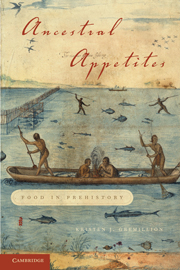Final Thoughts
Published online by Cambridge University Press: 05 June 2012
Summary
What the future holds for human food habits is anyone's guess. Our physiological and anatomical equipment is going to be more or less the same for a long time to come. The past of our species and its ancestors has done its work to shape us, for better or worse. Medical and genetic technologies still hold surprises, and some of the constraints of being Homo sapiens – primate, mammal, and heterotroph – may yet be relaxed. Gene therapy for metabolic disorders, pills to prevent fat accumulation, and vitamin-enriched rice cultivars are just a few of the developments on the horizon that have the potential to improve human nutritional status. But tweaking the organism will not erase millions of years of evolutionary history.
NOSTALGIA FOR THE PLEISTOCENE
One aspect of that heritage that causes health problems today is the tendency that many of us have to overindulge in fatty and sweet foods. In part, these preferences (which are not universal, but vary from one individual to the next) are a legacy of our millennia spent as hunter–gatherers, when sources of sugar and animal fats were not as easy to acquire as they are today. Foragers could afford to eat their fill of fruits, meat, and fat because they were seldom in danger of chronic overindulgence. High activity levels kept hearts strong and burned body fat. Supposedly, we remain in the grip of these preagricultural urges, which are no longer adaptive in a world of superabundant breakfast cereal, fast food, and torpidity.
- Type
- Chapter
- Information
- Ancestral AppetitesFood in Prehistory, pp. 146 - 152Publisher: Cambridge University PressPrint publication year: 2011

